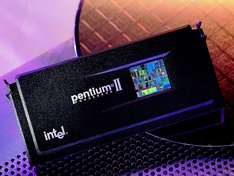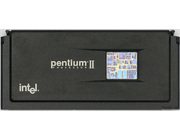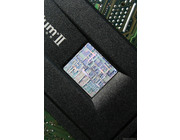Intel's first Pentium II processor. Introduced on 7 May 1997 and contains 7.5 million transistors. Basically it's an evolution of the Pentium Pro.
| The Pentium II was housed in a big plastic package (as seen on the right picture, click here for a bigger version). The big package has space for L2-cache since the Pentium II has 512KB off-die L2 cache running at 50% of the clock frequency. Off-die L2 cache is cheaper and simpler to manufacture which cut down on production costs. However, off-die L2 cache is slower than on-die L2 cache. The most notable improvements of the Pentium II are better execution performance of 16-bit code and a double L1-cache (from 16KB to 32KB). Of course the large off-die L2 cache improves performance. In a Pentium or Pentium MMX system the L2 cache would be installed on the motherboard which is further away from the CPU and uses a lower clock-frequency compared to the Pentium II. Klamath is superseded by Deschutes; which was produced with a 25nm process rather than 35nm. |  |




